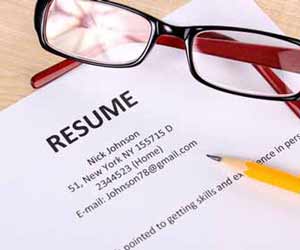Writing Your Resume
The Purpose of a Resume
Good resumes arouse interest, focus interviews, and serve as a reminder of your background. They can be effective marketing tools when dealing with potential employers and network contacts.

No serious job seeker should be without a resume, one that has been recently updated and looks professional. Today’s standards as to what constitutes a professional-looking resume, however, are somewhat open to interpretation. At one time, resumes had to be on white or beige paper with very conservative typefaces and no graphics or unusual design. With the advent of desktop publishing and the use of increasingly creative methods to sell everything from soda pop to automobiles, it’s not out of the question to market yourself with some tasteful modifications to the structure and look of the traditional resume. High-quality colored papers such as pale yellows, blues, greens, or grays are perfectly acceptable these days. The important thing to remember is to choose a color that enhances your resume without making it hard to read.
The same is true for typefaces and graphics. While creativity is generally a desirable trait to communicate to a prospective employer, your resume is not a vehicle to test strange new computer-generated graphics, unusual typefaces, or weird layouts. The primary function of your resume is to draw the employer’s attention to the aspects of your background that are most relevant to the requirements of the position.
One bit of conventional wisdom that has not changed over the years is resume length. Do whatever you can to keep it to one page. Those who are in a highly technical or specialized field may extend their resume to two pages, but never more than that. Keep in mind that most employers only spend about twenty seconds looking at each resume they receive, and worse, most employers view the information contained on resumes as a way to weed out applicants. With this in mind your resume should be concise enough to focus the employer’s attention, but general enough that you remain in the running for the position. Don’t clutter it with information that might be distracting. Rather than listing everything you’ve ever done or accomplished, be selective about what you share.
Again, the main purpose of your resume is to draw attention to how you can be of value to the employer.
Many people, especially those who own computers, customize resumes for each position. If you use a job objective, be sure to change it to match the need of the prospective employer. If you don’t have different resumes for different positions, avoid using an objective statement. In the eyes of the employer, your stated job objective may be too narrow or specific for the position and you will miss out.
There are three basic types of resumes:
- The chronological resume is a straightforward list of positions arranged in reverse-chronological order. It is best used to document a work history that involves positions of increasing responsibility and is the most common type of resume. It is especially good for beginning job seekers with little related experience but solid work history. The prospective employer can size up your background rapidly with this format; however, gaps in your work history will stand out. The chronological style is a good choice unless you have employment gaps, are changing fields, or are returning to a field after an extended absence. For a chronological resume worksheet, click here.
- The functional resume draws attention to your areas of expertise by listing them clearly, drawing on both paid and unpaid experience to describe your skills. Functional resumes are useful if you want to camouflage gaps in your work history or irrelevant past experience. They work well if you have a lot of experience in your target job field. Employers tend to be suspicious of strictly functional resumes, however, since they’re sometimes used to hide a spotty work history, so use them with discretion. They are most useful when pursuing a career change. For a functional resume worksheet, click here.
- A combination resume uses the best aspects of the functional and chronological styles. It describes your functional skills and includes a chronological summary of your work history. In this respect, it’s more flexible than either of the other two options; however, its form can appear cluttered or disorganized if you have a lot of information. If you choose this type of resume, try to make it streamlined. For a combination resume worksheet, click here.
Need professional help writing the perfect resume? We found a great service that will do it for you for a bargain price. Click here for more details.


 Teach English in Asia
Teach English in Asia  Cruise Ship Jobs
Cruise Ship Jobs  Alaska Fishing Industry Jobs
Alaska Fishing Industry Jobs  Sharing Economy / Gig Economy
Sharing Economy / Gig Economy